Key Scottish Environment Statistics 2015
This publication aims to provide an easily accessible reference document which offers information on a wide range of environmental topics. It covers key datasets on the state of the environment in Scotland, with an emphasis on the trends over time wherever possible. The data are supplemented by text providing brief background information on environmental impacts and data source, a summary of the trend and brief information on the potential factors affecting the trend.
Water
Background
Water is vitally important for a number of areas as it supports a variety of wildlife, is an important resource for tourism and recreation and provides domestic and commercial water supplies. Water quality can be negatively affected by the enrichment of nutrients such as nitrates and orthophosphates, which can affect aquatic ecosystem health, and by the presence of certain bacteria which can pose a potential risk to public health.
| Water body type |
Approximate area/length (to the nearest thousand) |
Additional fact |
| Rivers |
125,000 km |
There are also 220 km of canals in Scotland |
| Lochs |
2,000 km2 |
There are 25,500 lochs in Scotland - over 17,637 of these cover less than 0.01 km2. |
| Estuaries |
1,000 km2 |
There are 49 estuaries in Scotland assessed through the Water Framework Directive, including 9 salt-water lagoons. |
| Coastal Waters |
48,000 km2 |
Scotland has approximately 19,000 km of coastline |
| Offshore Waters |
462,000 km2 |
Scottish offshore waters extend from 3 km from the coast to the Exclusive Economic Zone (EEL). |
Maintaining water health
Maintaining the health of Scotland's water bodies is important for protecting drinking water supplies, protecting wildlife and for industries such as tourism, aquaculture and whisky production.
There are a number of pressures on the health of Scotland's water bodies including rural diffuse pollution, waste water and hydropower generation. Rural diffuse pollution can occur when rainwater run-off from land picks up soil, fertilisers and pesticides used in agriculture, forestry and other rural land uses which can in turn result in eutrophication[69]. Scottish Environment Protection Agency (SEPA) has an extensive monitoring network, which focusses on high priority areas, to monitor the general health of Scotland's water bodies and to help target action when required.
Scottish Water is the body responsible for public water supplies and for monitoring the quality of drinking water that it supplies.
Targets and Indicators
SEPA compile a long term river water quality indicator based on 5 parameters (see River Water Quality: 1992-2014). There are also various standards to be met for:
- The quality of Scottish bathing waters - set out in the EC Bathing Water Directive (76/160/EEC)
- The quality of drinking water - set out in the Water Supply (Water Quality) (Scotland) Regulations 2001[70]. These have now been superseded by the Public Water Supplies (Scotland) Regulations 2014.
Public Water Supplies - Water Abstracted and Supplied: 2002/03-2014/15[71],[72]
Million litres per day (Ml/d)
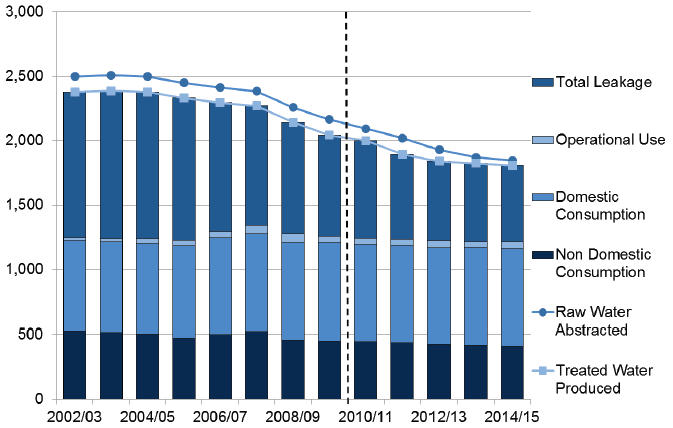
Why this measure is important
For sustainable management of water resources, it is essential to meet consumer demand whilst maintaining aquatic ecosystem health. The abstraction of water can have impacts on geology, habitats, wildlife and biodiversity.
Background
Water abstraction is managed by Scottish Water and Scottish Environment Protection Agency under the Water Resource Planning and River Basin Management Planning Processes.
Trend
Between 2002 and 2009, estimated raw water abstractions by Scottish Water decreased by 13% to 2,165 Ml/d. Between 2010 and 2014, using improved data and methodology, the volume of raw water abstracted also decreased by 12% to 1,847 Ml/d[72]. Between 2004/05 and 2014/15, treated water produced fell by 571 Ml/d (24%) to a new low of 1,807 Ml/d. There has been a slight increase of 60 Ml/d (9%) in domestic water consumption between 2004/05 and 2014/15, while non-domestic water consumption has decreased by 93 Ml/d (18%) over the same period. However, there has been relatively little change in all water consumption overall (domestic, non-domestic and operational use[73]) between 2004/05 and 2014/15.
Factors affecting trend
The decrease in treated water is almost entirely due to a reduction in leakage[74],[75] of 549 Ml/d (48%) between 2004/05 and 2014/15. The increase in domestic water consumption partly reflects an increase in the number of households and the decrease in non-domestic water consumption reflects the introduction of the retail market, where retailers offer customers advice on how to reduce their water and sewerage bills.
Source: Scottish Water | Metadata
Drinking Water Quality: 1992-2014
Percentage of samples at consumers' taps containing coliform bacteria
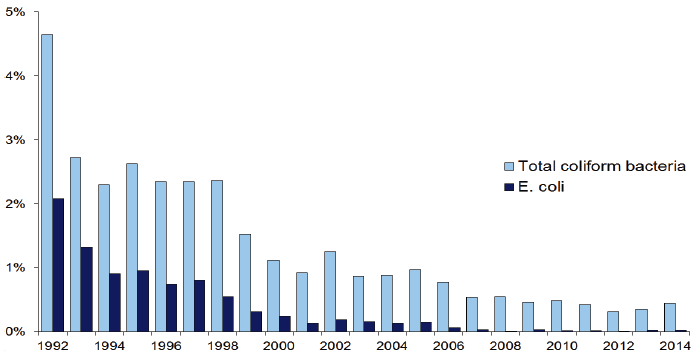
Why this measure is important
The coliform group of bacteria is present in the gut of all warm-blooded animals and is widely distributed in the environment. Their presence in tap water indicates a breach in the integrity of the water supply system.
Background
Scottish Water is required to analyse samples taken from water treatment works, service reservoirs and consumers' taps to test for the presence of coliform bacteria. Samples containing coliform bacteria fail to meet the standards set out in the Water Supply (Water Quality) (Scotland) Regulations 2001[76]. These regulations have now been superseded by the Public Water Supplies (Scotland) Regulations 2014, which sets out the standards to be met by the 2015 tests. The Drinking Water Quality Regulator for Scotland publishes an annual report summarising this data[77].
Trend
Between 1992 and 2014, the percentage of samples from consumer taps containing coliform bacteria fell from 4.64% to 0.45% and the percentage containing Escherichia coli (E.coli) fell from 2.08% to 0.02%. Between 2013 and 2014 the failure rate for total coliforms increased by 0.09 percentage points to a level similar to that recorded in 2012, while the failure rate for E. coli remained fairly constant.
Factors affecting trend
Most of this overall improvement is the result of investments made at water treatment works across the country over the past ten years. In recent years, many improvements have been made to most of the small, rural treatment works that have historically been unable to consistently and satisfactorily treat water to the standard required by the Regulations.
Source: Drinking Water Quality Regulator For Scotland | Metadata
River Water Quality: 1992-2014R
Distribution of river water quality, percentage of river length within each band
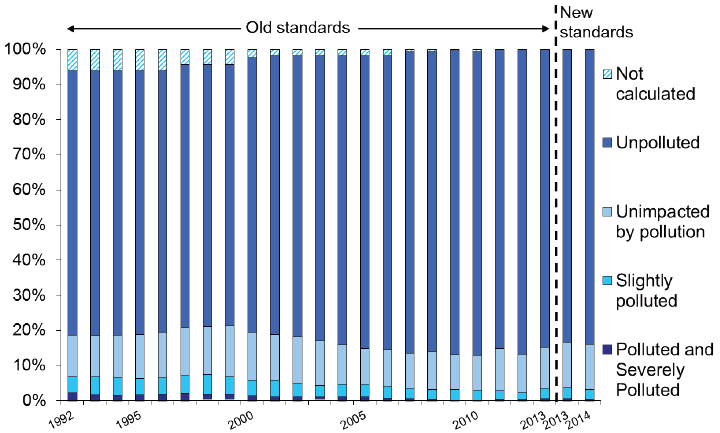
Why this measure is important
Low standards of river water quality may threaten the aquatic environment, drinking water quality and impact on recreational water use. River water quality can be affected by a number of factors including sewage, industry, urban development and agriculture.
Background
The Scottish Environment Protection Agency (SEPA) long term indicator of river water quality is based on a network of sites covering 253 water bodies (rivers or sections of rivers), which account for approximately 10% of all water bodies in Scotland. Two of the standards used to calculate the indicator were changed in 2013[78]. In this indicator, river water quality is classified as 'unimpacted by pollution,' 'unpolluted', 'slightly polluted', 'polluted', or 'severely polluted'. The 'polluted' and 'severely polluted' categories have been combined on the chart above so that they can be seen more clearly.
Trend
The proportion of river length that was classed as slightly polluted, polluted or severely polluted in Scotland rose from 6.8% in 1992, to 7.4% in 1998, before falling to 3.4% in 2013, using the old standards. Using the new standards, this proportion fell from 3.7% in 2013 to 3.2% in 2014. The proportion of river length classed as unpolluted fell from 86.5% in 2010 to 84.8% in 2013. Using the new standards, the proportion of river length classed as unpolluted rose from 83.3% in 2013 to 84.1% in 2014. In 2014, the proportion of river length classed as unimpacted by pollution was 12.8%.
Factors affecting this trend
The main drivers of slightly polluted, polluted and severely polluted rivers are inputs of nutrients, such as those from agriculture and waste water treatment works, leading to degraded biological and nutrient quality. In general, Scottish water quality has improved following the investments made to the sewage infrastructure in Scotland.
Source: Scottish Environment Protection Agency | Metadata
Nitrate Concentrations in Rivers: 2000-2014
Distribution of mean nitrate concentrations, percentage of sites[79] within each band
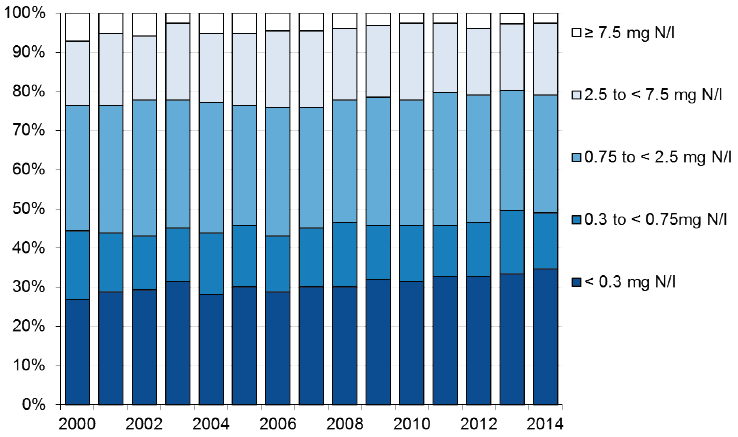
Why this measure is important
The enrichment of waters by nutrients, such as nitrates and phosphates, may lead to the damage of the aquatic environment through eutrophication. Therefore, monitoring of the water environment for nutrient enrichment is important to protect water quality. Although some freshwater lochs can be at risk, high nitrate levels tend to have a greater impact on marine and coastal waters than on freshwater.
Background
The chart above is based on concentrations at the 153 sites where four or more samples per year have been taken each year since 2000, to provide a consistent time series.
Trend
Nitrate concentrations below 0.3 mg N/l are considered to be natural or background levels[80]; the percentage of sites with mean nitrate concentrations of < 0.3 mg N/l has increased from 27% in 2000 to 35% in 2014. In 2014, less than 3% of sites had nitrate concentrations over 7.5 mg/l compared with over 7% of sites in 2000.
Factors affecting trend
The main source of nitrates in freshwater is from agriculture; nutrients are important for crop growth and good nutrient management is crucial to ensure there is no excessive loss to the water environment. Regulations have been made designating 14% of the area of Scotland[81] as Nitrate Vulnerable Zones (NVZs)[82], in which mandatory rules on farming practices aim to reduce nitrate water pollution from agricultural sources.
Source: Scottish Environment Protection Agency | Metadata
Orthophosphate Concentrations in Rivers: 2000-2014
Distribution of mean orthophosphate concentrations[83], percentage of sites in each band
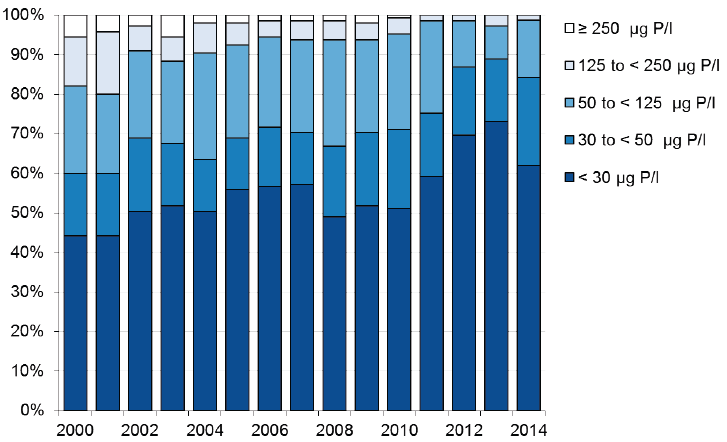
Why this measure is important
Raised levels of orthophosphate in freshwaters may lead to eutrophication. The main source of phosphorus is diffuse pollution from agriculture, but there is also a risk that discharges from waste water treatment works contain phosphates.
Background
The chart above is based on concentrations at the 145 sites where four or more samples per year have been taken each year since 2000, to provide a consistent time series.
Trend
The percentage of sites with orthophosphate concentrations less than 30 μg P/l has generally increased over time from 44% in 2000 to 73% in 2013 before falling to 62% in 2014. The percentage of sites with concentrations in excess of 125 μg P/l has generally fallen over this period.
Factors affecting trend
These changes mainly reflect the improvements in water quality following the investments made to the sewage infrastructure in Scotland. Under the Urban Waste Water Treatment Directive (UWWTD) (91/271/EEC), catchments where nutrient levels are considered to be high are designated as sensitive areas. Discharges into waters that have been designated as sensitive require additional treatment to remove nutrients.
Source: Scottish Environment Protection Agency | Metadata
Compliance with the EC Bathing Water Directive (76/160/EEC): 1988-2014
Percentage compliance of coastal bathing waters[84]
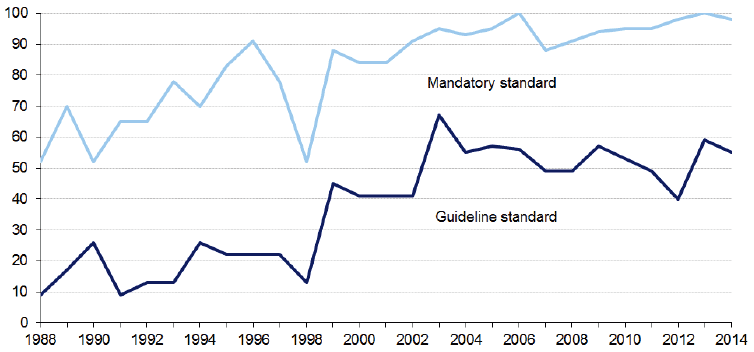
Why this measure is important
There is a potential risk to public health if high concentrations of faecal bacteria are present in bathing waters. This can occur if heavy rain leads to increased surface water run-off in urban areas and fields, which causes contaminants to enter the water.
Background
The EC Bathing Water Directive (76/160/EEC) sets out requirements for Member States to monitor and assess the water quality at designated bathing waters, and provide public information on the results.
The Directive sets out two quality standards - the 'mandatory' standard and the stricter 'guideline' standard. Designated bathing waters should comply, as a minimum, with the mandatory standard and aim to comply with the guideline standard. From 2015, bathing water will be assessed by a new standard on bathing water quality, based on the previous four years performance.
Trend
In 2014, all but two of Scotland's coastal bathing waters met the mandatory standard, with 56% of Scotland's bathing waters also achieving the guideline standard. In general, there has been an improvement in compliance with the mandatory standard in recent years.
Factors affecting trend
Weather can have a large effect on the compliance of bathing waters, as heavy rain can lead to overflows from drains and surface water run-off from fields containing animal manure which raises the risk of sites failing to meet the required standard.
Contact
Email: Kirsty Ciclitira
There is a problem
Thanks for your feedback